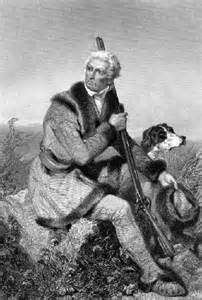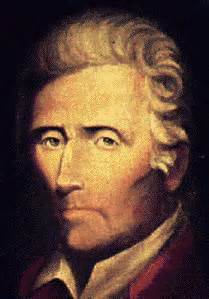Daniel Boone is one of America's most famous explorers. He is perhaps more well-known for fictional accounts of his life and actions than for things that he actually did. Still, his accomplishments were significant. Boone was born in Pennsylvania in the early 1730s. (Sources do not agree on his date of birth.) His father, Squire Boone, and mother, the former Sarah Morgan, came to America from England in the early 18th Century. Squire Boone had several occupations, including blacksmith, weaver, and farmer. Daniel was his parents' sixth child and had little formal education (which was not uncommon, actually, in those days). His mother taught him how to read and write, and his father taught him survival skills, including giving the boy his first gun at age 12. In the mid-1750s, Boone married Rebecca Bryan. They lived in a log cabin that he built and had several children.
Fellow hunter John Finley convinced Boone to join him on an expedition to what is now Kentucky in 1769. They made their way through the Cumberland Gap and later fleshed out what is now called the Wilderness Road. They were soon involved in skirmishes with Native Americans living in the area. Fighting along with them was Lord Dunmore. (This series of skirmishes is sometimes called "Lord Dunmore's War.") To solidify their position, Boone and others built a fort on the Kentucky River. The fort became the settlement of Boonesborough; once the settlement became stable, Boone moved his family there, in 1776. Tensions between English settlers and Native Americans were high on the frontier. Native American raids on Boonesborough and other locations were not uncommon. In one such raid, a group of Shawnee captured one of Boone's daughters. Boone was successful in rescuing her. Boone himself was captured in 1778 and spent several weeks in a Shawnee settlement before making his way back to Boonesborough. When he returned, however, he discovered that his family, thinking him dead, had moved to North Carolina, to near Boone's wife's father. Boone, who had returned in time to repel yet another Native American attack, traveled to North Carolina and convinced his wife and children to return to Boonesborough with him, in 1780. Boone had particularly poor fortune in his business dealings. More than once, land he thought he owned turned out to be worthless to him, as the property changed hands from one national government to another. (The Louisiana Purchase nationalized much land formerly owned by Spain and then France, and Boone was victimized by this. He also lacked a clear certificate of ownership of his family's land and so lost out when Kentucky became a state, in 1792.) Before that, he had been a surveyor in Kentucky and had racked up large amounts of debt in land deals gone bad. Boone was a politician as well as an explorer and militiaman. He served three terms in the Virginia General Assembly during the Revolutionary War and was also sheriff of one of the settlements in which he lived. Boone and his family lived in Kentucky and Virginia until 1798, when they moved to Missouri. He died there in 1820 and was buried next to his wife, who had died seven years earlier. The legacy of Daniel Boone is that of an iconic figure, an adventurer larger than life. This picture began to take shape in 1784, with the publication of a book titled The Discovery, Settlement and Present State of Kentucke [sic]. The book, written by John Filson, contained one story titled "The Adventures of Colonel Daniel Boon," a mostly factual account of Boone's adventures in Kentucky. Filson invented much of Boone's words.
Boone is also thought to be one of the inspirations for certain parts of James Fenimore Cooper's The Last of the Mohicans, published in 1826. Boone's reputation was well-known outside the United States as well. The famous English poet Lord Byron mentioned Boone in his epic poem Don Juan, in 1822. Daniel Boone featured as a character in a great many forms of entertainment throughout the 19th and the 20th Century, including radio programs, movies, comic strips, and television programs. |
|
Social Studies for Kids
copyright 2002–2025
David White

 Rugged by nature, Daniel Boone enjoyed hunting, exploring, and trapping. He also served in the local militia and fought briefly in the French and Indian War, under the common of General Edward Braddock, and briefly was well in the
Rugged by nature, Daniel Boone enjoyed hunting, exploring, and trapping. He also served in the local militia and fought briefly in the French and Indian War, under the common of General Edward Braddock, and briefly was well in the  Another popular recounting of Boone's story was Timothy Flint's Biographical Memoir of Daniel Boone, the First Settler of Kentucky. Published in 1833, this became one of the best-selling biographies of the 19th Century. As did Filson, Flint embellished Boone's actions and words, creating a larger-than-life persona for the recently deceased pioneer. In one particularly memorable passage, Flint tells how Boone fought hand-to-hand with a bear.
Another popular recounting of Boone's story was Timothy Flint's Biographical Memoir of Daniel Boone, the First Settler of Kentucky. Published in 1833, this became one of the best-selling biographies of the 19th Century. As did Filson, Flint embellished Boone's actions and words, creating a larger-than-life persona for the recently deceased pioneer. In one particularly memorable passage, Flint tells how Boone fought hand-to-hand with a bear. 
